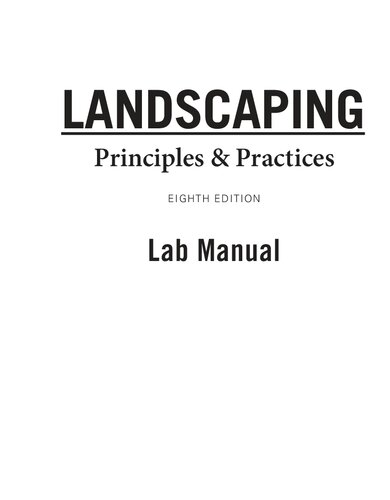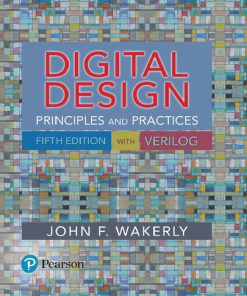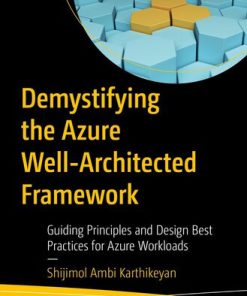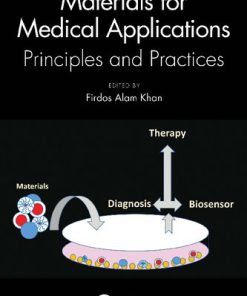Landscaping Principles and Practices 8th Edition by Jack Ingels, Alissa F Smith ISBN 9781337403436 1337403431
$50.00 Original price was: $50.00.$25.00Current price is: $25.00.
Landscaping Principles and Practices 8th Edition by Jack Ingels, Alissa F Smith – Ebook PDF Instant Download/Delivery: 9781337403436 ,1337403431
Full download Landscaping Principles and Practices 8th Edition after payment
Product details:
ISBN 10: 1337403431
ISBN 13: 9781337403436
Author: Jack Ingels, Alissa F Smith
Landscaping Principles and Practices 8th Edition Table of contents:
Section 1. Overview of Landscape Design
Chapter 1. Introduction to the Landscape Industry
An Overview of the Landscape Industry
Careers in Landscaping
Landscape Architect
Landscape Designer
Landscape Contractor
Landscape Management
The Evolving Landscape Industry
Experiential Learning
Summary
Achievement Review
Student Activities
Suggested Supervised Agricultural Experience (SAE) Activities
Chapter 2. The Principles of Design
The Foundation for Designing
Balance
Focalization of Interest
Simplicity
Rhythm and Line
Proportion
Unity
Applying the Principles of Design to Landscape Designing
Applying the Principle of Balance
Applying the Principle of Focalization of Interest
The Corner Planting
Applying the Principle of Simplicity
Applying the Principle of Rhythm and Line
The Line Planting
Foundation Plantings
Applying the Principle of Proportion
Applying the Principle of Unity
Material Characteristics Supportive of the Design Principles
Architecture
Plant Materials
Hardscape Materials
Summary
Achievement Review
Student Activities
Suggested Supervised Agricultural Experience (SAE) Activities
Chapter 3. Using Drawing Instruments
The Purposes of the Drawings and the Tools of Choice
The Tools and How They Work
Summary
Achievement Review
Student Activities
Suggested Supervised Agricultural Experience (SAE) Activities
Chapter 4. Lettering
The Importance of Lettering
Methods of Lettering
Lettering Templates
Waxed Press-on Letters
Transfer Film
Hand Lettering
Changing the Center Guideline
Changing the Number of Guidelines
Hand Lettering Techniques and Tips
Introducing Line-Width Variation
Summary
Achievement Review
Student Activities
Suggested Supervised Agricultural Experience (SAE) Activities
Chapter 5. Graphic Materials and Techniques
Same Design, Different Views
Plan Views
Landscape Symbols
Needled Evergreens
Broadleaved Evergreens
Deciduous Shrubs
Deciduous Trees
Vines
Trailing Groundcovers
Hardscape Materials
Explaining an Idea with Symbols
Labeling
Symbol Labeling
Plant Lists
Scale Indicator and Directional Arrow
Client and Designer Names
Design Sheet Layout
Different Drawings for Different Requirements
Graphic Media
Graphite Pencil
Colored Pencil
Felt Marker Pens
Color Markers
Pastels
Foam Board
Drawing Papers and Films
Print Papers
The Layout of Graphic Presentations
Summary
Achievement Review
Student Activities
Suggested Supervised Agricultural Experience (SAE) Activities
Section 2. The Landscape Design Process
Chapter 6. The Landscape Process
Landscaping as a Process
Project Development as a Process
Project Maintenance as a Process
Design as a Process
Interviewing the Client
Program Information Gathering
Interpreting the Client
What Isn’t the Client Telling You?
The Budget
Bringing the Site and Program Inventories Together
Diagrams and Drawings Within the Design Process
Summary
Achievement Review
Student Activities
Suggested Supervised Agricultural Experience (SAE) Activities
Chapter 7. The Site
Understanding the Site
Site Features and Characteristics
Sources of Site Information
Geographic Information System and the Global Positioning System
Reading the Terrain
The Need for Terrain Information
Grading the Land
Performing a Site Analysis
Preparing a Base Map
Summary
Achievement Review
Student Activities
Suggested Supervised Agricultural Experience (SAE) Activities
Chapter 8. Plant Selection
Designing with Plants
The Origins of Landscape Plants
Plant Forms Available
How Landscape Plants Are Sold
Plant Nomenclature
Selecting the Proper Plant
Selection Factors
Role Factors
Hardiness Factors
Heat Zone Considerations
Physical Factors
Cultural Factors
Grading Standards
Computer-Aided Plant Selection
Summary
Achievement Review
Student Activities
Suggested Supervised Agricultural Experience (SAE) Activities
Chapter 9. Flowers
The Uses and Limitations of Flowers in the Landscape
Using Flowers Properly
The Limitations of Use
Different Flowers Have Different Life Spans
Annuals
Perennials
Bulbous Perennials
Biennials
Flower Beds and Flower Borders
Designing Flower Plantings
Naturalized Plantings
Summary
Achievement Review
Student Activities
Suggested Supervised Agricultural Experience (SAE) Activities
Chapter 10. Hardscape
Hardscape: An Umbrella Term
Selection Criteria
Familiar Materials in New Roles
Changing Levels in the Landscape
Design Concerns
Technical Concerns
Walks, Drives, and Stepping Stones
Water Features
Design Concerns
Constructing a Recirculating Water Feature
Outdoor Lighting
Design Concerns
The System
Creating the Lighting Plan
Summary
Achievement Review
Student Activities
Suggested Supervised Agricultural Experience (SAE) Activities
Chapter 11. Enrichment
Landscape Enrichment Is Something Extra
Tangible and Intangible, Natural and Fabricated
Tangible, Natural Enrichment
Tangible, Fabricated Enrichment
Intangible Enrichment
Is the Enrichment Item Necessary?
Summary
Achievement Review
Student Activities
Suggested Supervised Agricultural Experience (SAE) Activities
Chapter 12. Pricing the Proposed Design
Cost Determinations
Cost and Price
Estimates and Bids
Specifications
Preparing the Estimate
Summary
Achievement Review
Student Activities
Suggested Supervised Agricultural Experience (SAE) Activities
Chapter 13. Presenting the Proposal
The Purpose of the Proposal
Clarifying the Objectives
Presentations Take Many Forms
Presenting the Company’s Qualifications
The Style Should Match the Setting
You Are the Project—Dress Accordingly
Assist the Clients—Don’t Sell Them
Listen and Learn
Closing the Presentation
Summary
Achievement Review
Student Activities
Suggested Supervised Agricultural Experience (SAE) Activities
Section 3. Landscape Contracting
Chapter 14. Landscape Calculations
The Landscape Take-Off
The Necessary Calculations
Sources of the Data
Standardized Technique Is Important
Typical Sequence of Calculations for Landscape Take-Offs
Typical Calculations Required for Take-Offs
Linear and Surface Area Measurements
Volume Measurement
Time Calculations
Quantity Calculations and Conversions
Soil Compaction Calculations
Pit and Ball Calculations
Trench Volumes
Achievement Review
Student Activities
Suggested Supervised Agricultural Experience (SAE) Activities
Chapter 15. Understanding Contracts and Contractors
The Importance of Contracts
The Components of a Contract
Types of Contractual Associations
How Landscape Contractors Are Selected
Direct Solicitation
Noncompetitive Selection
Competitive Bidding
The Advantages and Disadvantages
The Need for Documents
The Documents
Standard Form of Agreement
Invitation to Bid
Drawings and Specifications
Bid Form
Noncollusion Affidavit
Bid Bond
Performance Bond
Subcontract and Material Bid Invitations
Subcontract
Notice to Proceed
Labor and Material Payment Bond
Change Order
Certificate for Payment
Certificate of Final Completion
The Complete Contract
Summary
Achievement Review
Student Activities
Suggested Supervised Agricultural Experience (SAE) Activities
Chapter 16. Specifications
Importance of Specifications
Project Manuals
Masterformat
Standard and Customized Specifications
Uniformity in Preparation of Project Manuals
Methods of Specifying
Sources of Specification Data
Closed and Open Specifications
When Changes Are Needed
Summary
Achievement Review
Student Activities
Suggested Supervised Agricultural Experience (SAE) Activities
Chapter 17. Human Resources: The Needs and the Opportunities
Staffing: The Industry’s Number One Problem
Career Recruitment Opportunities
Qualities Needed for Career Success
Successful Matchup: Creating a Win–Win Relationship
Summary
Achievement Review
Student Activities
Suggested Supervised Agricultural Experience (SAE) Activities
Section 4. Landscape Installation
Chapter 18. Safety in the Landscape Industry
It’s a Risky Business
The Potential Dangers
The Probable Causes
Safety Regulations Established by Government
Vehicle Safety
Chemical Safety
Workers’ Compensation
The Occupational Safety and Health Administration (OSHA)
Safety Awareness Is Promoted by the Landscape Industry
Safe Practice at the Work Site
Even Safety Has Its Problems
Summary
Achievement Review
Student Activities
Suggested Supervised Agricultural Experience (SAE) Activities
Chapter 19. Tools of the Trade
The Importance of Tools
Hand Tools
Hand Tool Maintenance
Power Tools and Their Functions
Equipment Maintenance
Storing Hand Tools and Small Power Equipment
Summary
Achievement Review
Student Activities
Suggested Supervised Agricultural Experience (SAE) Activities
Chapter 20. Installing Landscape Plants
The Importance of Proper Installation
The Necessary Tools
The Time to Transplant
The Soil for Installation
Methods of Installation
Trees and Shrubs
Bare-Rooted Plants
Containerized Plants
Balled and Burlapped Plants
Correct Backfilling
Staking and Guying
Protecting Thin-Barked Trees
Groundcovers and Bedding Plants
Bulbs
Mulching
Using Antitranspirants
Summary
Achievement Review
Student Activities
Suggested Supervised Agricultural Experience (SAE) Activities
Chapter 21. Selecting the Proper Grass
Turfgrass
Comparison of Turfgrasses
Growth Habits
Texture, Color, and Density
Size of Seed
Soil and Climatic Tolerance
Use Tolerance
Disease and Insect Resistance
Purchasing Grass Seed
Purity
Mixtures, Blends, and Single-Species Lawns
Summary
Achievement Review
Student Activities
Suggested Supervised Agricultural Experience (SAE) Activities
Chapter 22. Lawn Construction
Selecting the Method of Lawn Installation
Seeding
Sodding
Plugging
Sprigging and Stolonizing
Proper Lawn Construction
Time of Planting
Grading and Draining the New Lawn
Conditioning the Soil
Planting the Lawn
Seed
Sod
Plugs
Sprigs
The Importance of Watering
The First Mowing
Calibrating a Spreader
Summary
Achievement Review
Student Activities
Suggested Supervised Agricultural Experience (SAE) Activities
Chapter 23. Landscape Irrigation
Irrigation
Types of Landscape Irrigation Systems
The Terminology of Landscape Irrigation
Sprinkler Head
Sprinkler Irrigation
Sprinkler Heads
Precipitation Rates
Geographical Areas
Sizing Irrigation Pipe
Matching Water Flow and Pressure with Pipe Size
Calculating Working Water Pressure
Calculating Static Water Pressure
Calculating Dynamic Water Pressure
Selecting and Locating Sprinklers
Sprinkler Pattern
Locating the Sprinklers
Trickle Irrigation
Emitters
Tube and Emitter Placement
The Future
Summary
Achievement Review
Student Activities
Suggested Supervised Agricultural Experience (SAE) Activities
Section 5. Landscape Maintenance
Chapter 24. Maintaining Landscape Plants
Sustained Care of Plantings
Watering
Fertilization
Aeration
Mulching
Edging
Pest Control
Maintenance of Flower Plantings
Weed Control
Watering
Fertilization
Dead-Heading
Pinching
Summary
Achievement Review
Student Activities
Suggested Supervised Agricultural Experience (SAE) Activities
Chapter 25. Pruning Trees and Shrubs
Pruning Trees and Shrubs
The Tools
Parts of a Tree
Parts of a Shrub
The Proper Time to Prune
Winter Pruning
Summer Pruning
Autumn Pruning
Spring Pruning
Parts of the Plant to Prune
Pruning Methods
How to Prune Hedges
National Pruning Standard
Summary
Achievement Review
Student Activities
Suggested Supervised Agricultural Experience (SAE) Activities
Chapter 26. Plant Injuries: Identification and Care
Plant Injuries and Their Causes
Different Forms at Different Times
How Insects and Diseases Are Spread
The Symptoms of Injury
Wilting
Color Changes
Rotting
Death of Tissue
Dwarfing
Increase in Size
Tunneling
Holes
Determining the Cause
Look for Signs
Weeds
Classification of Weeds
Annuals
Perennials
The Principles of Control
Exclusion
Eradication
Protection
Resistance
Pesticides
Pesticide Formulations
Solutions
Emulsifiable Concentrates
Wettable Powders
Granules and Pellets
Fumigants
Flowable Suspensions
Dusts
Water-Dispersible Granules
Gels
Integrated Pest Management
Summary
Achievement Review
Student Activities
Suggested Supervised Agricultural Experience (SAE) Activities
Chapter 27. Care of the Lawn
Lawn Care
Spring Cleanup
Rolling of the Lawn
The First Cutting
Patching the Lawn
Aeration
Clippings
Lawn Fertilization
Nutrient Analysis and Ratio
Trace Elements
Forms of Nitrogen Content
Fillers
When to Fertilize Lawns
Amount of Fertilizer
Watering the Lawn
Mowing the Lawn
Damage to Lawns
Weeds and Pests
Thatch Build-Up
Drought
Vandalism
Summary
Achievement Review
Student Activities
Suggested Supervised Agricultural Experience (SAE) Activities
Chapter 28. Winterization of the Landscape
Winter Injury
Types of Winter Injury
Natural Injuries
Human-Induced Injuries
Reducing Winter Injury
Summary
Achievement Review
Student Activities
Suggested Supervised Agricultural Experience (SAE) Activities
Chapter 29. Pricing Landscape Maintenance
The Need for Cost Analysis in Landscape Maintenance
Two Methods of Maintenance Cost Calculations
Comparison Pricing
Unit Pricing
Calculations for Unit Cost Analysis
The Completed Cost Estimate
Summary
Achievement Review
Student Activities
Suggested Supervised Agricultural Experience (SAE) Activities
Section 6. Specialization in the Landscape Industry
Chapter 30. Landscaping in the Age of Technology
Technology Is Dynamic
The Necessary and the Novel
Sources of New Technology
The Forms and Types of Technology in Landscaping
Design Software
The Tools Required for Computer Drafting
Technological Advances in the Field
The Future
Summary
Achievement Review
Student Activities
Suggested Supervised Agricultural Experience (SAE) Activities
Chapter 31. Xeriscaping
Xeriscape: Water-Wise Landscaping
The Benefits of Xeriscaping
Economic Benefits
Environmental Benefits
Aesthetic Benefits
The Seven Principles of Xeriscaping
The First Principle: Proper Planning and Design
The Second Principle: Proper Soil Analysis
The Third Principle: Appropriate Plant Selection
The Fourth Principle: Practical Turf Areas
The Fifth Principle: Efficient Irrigation
The Sixth Principle: Mulching
The Seventh Principle: Appropriate Maintenance
Applying Xeriscape Principles to Designing
Additional Water-Saving Ideas
Summary
Achievement Review
Student Activities
Suggested Supervised Agricultural Experience (SAE) Activities
Chapter 32. Interior Plantscaping
Containerizing Plants, Past and Present
The Materials
Uniqueness of Interior Plantscapes
Light and Interior Plantings
Light Intensity
Acclimatization
Light Intensity Acclimatization
Nutrient Acclimatization
Moisture Acclimatization
Temperature Acclimatization
Light Quality
Determining Total Radiation
Natural Light
Selecting the Correct Lighting
The Growing Medium
Installing the Plants
Watering and Drainage
Other Concerns
Fertilization
Humidity
Air Pollution
Dust
Pruning
Repotting
Insects and Diseases
Vandalism and Abuse
Grouping Compatible Species
The Future
Summary
Achievement Review
Student Activities
Suggested Supervised Agricultural Experience (SAE) Activities
Chapter 33. Water Gardens
The Water Garden as a Component of the Larger Garden
The Materials
Balancing Nature in the Water Garden
Site Selection and Soil Type
The Choice of Plants
Planting and Installing Aquatics
Overwintering the Water Garden
Summary
Achievement Review
Student Activities
Suggested Supervised Agricultural Experience (SAE) Activities
Appendix A. Examples of Landscape Designs
Appendix B. From Drawing to Reality
Appendix C. Examples of Plant Diseases and Insect Injuries
Appendix D. Professional and Trade Organizations
Appendix E. Supervised Agricultural Experience
People also search for Landscaping Principles and Practices 8th Edition:
a student’s guide to estates in land and future interests
landscape design introduction student worksheet answers
glencoe business and personal law student edition
glencoe business and personal law student edition pdf
principles of landscape design pdf
Tags: Jack Ingels, Alissa F Smith, Landscaping, Principles, Practices
You may also like…
Relationships & Lifestyle - The Art of Communication
Environmental Risk Communication Principles and Practices for Industry 2nd Edition Forney
Computers - Computer Science
Digital Design Principles and Practices 5th Edition by John Wakerly ISBN 9780134460093 013446009X
Mathematics - Applied Mathematics
Principles and Practices for a Federal Statistical Agency 7th Edition Citro
Engineering - Computer Technology
Design Principles for Embedded Systems by Kcs Murti 9789811632938 9811632936
Technique - Materials
Materials for Medical Applications: Principles and Practices 1st Edition Firdos Alam Khan












